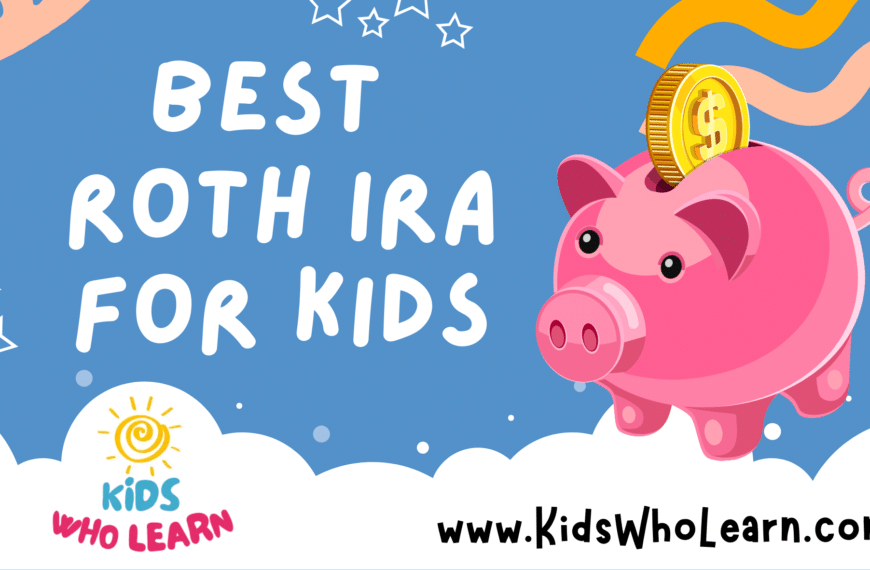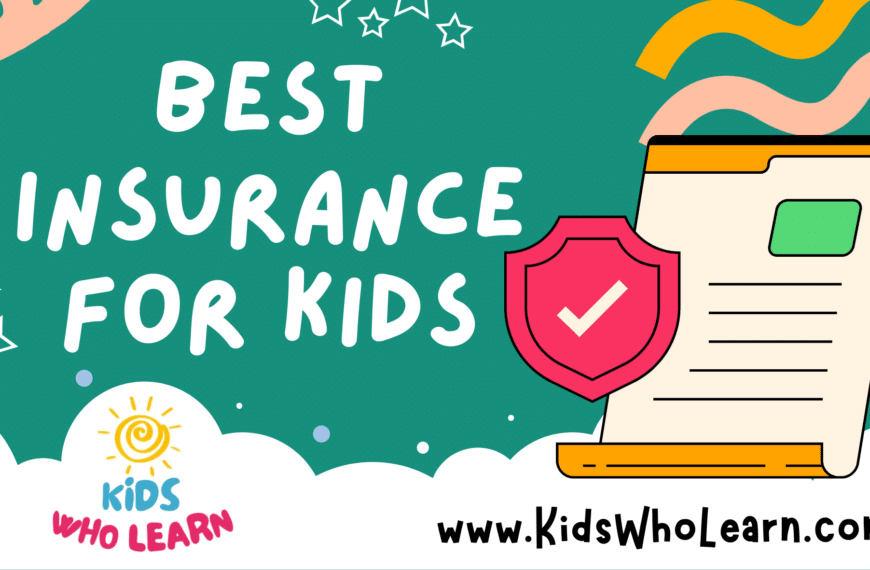Securing the financial future of a child can be a top priority for many parents and guardians. Whole life insurance for kids is not only a thoughtful gift that can provide long-term financial support, but it also has the potential to serve as a building block for their future financial stability. This type of policy guarantees life insurance coverage for the child’s entire lifetime, provided premiums are paid as required.
When considering whole life insurance for a child, it’s important to understand the specifics of the policy being offered. Whole life policies typically include a set premium and a cash value component that grows over time, which can later be borrowed against or withdrawn under certain conditions. Enrollment at a young age can lock in lower premium rates and start the cash value accumulation early, which can be beneficial in the long run.
Key Takeaways
- Whole life insurance ensures lifetime coverage and financial support for children.
- Policies include fixed premiums and a cash value component with growth potential.
- Early enrollment offers financial benefits and savings on premium costs.
Understanding Whole Life Insurance for Kids
When considering life insurance for children, it’s important to understand the specifics behind whole life policies: their lifelong coverage, potential cash value accumulation, and how they compare to term life insurance.
Fundamentals of Whole Life Insurance
Whole life insurance is a type of permanent life insurance that provides coverage for your child’s entire life, as long as premiums are paid. Unlike term life insurance, which lasts for a specific period, whole life insurance does not expire. The policy includes a death benefit, which is a set amount paid out upon the insured’s death, and a cash value component that grows over time. Policies generally have fixed premiums that do not increase as your child ages.
- Coverage: Lifelong protection
- Premiums: Fixed, generally does not increase with age
- Death Benefit: Guaranteed payout upon death
- Cash Value: Savings component that grows tax-deferred
Advantages of Whole Life Insurance for Children
Purchasing whole life insurance for your child can lock in low premium rates and provide financial benefits for their future. Since children are typically in good health, premiums for child life insurance are lower. The cash value accumulates over time and can be borrowed against for future expenses like education or a home purchase. Additionally, securing coverage now ensures they have life insurance regardless of future health changes.
- Low Premiums: More affordable when the insured is a child
- Financial Tool: Cash value can help fund future significant expenses
- Guaranteed Insurability: Coverage regardless of future health
Whole Life vs. Term Life Insurance
Understanding the differences between whole life and term life insurance is crucial when considering a policy for your child. Term life insurance offers coverage for a set period, such as 10 or 20 years, and then expires if the death benefit is not claimed. It does not include a cash value component. Whole life insurance, by contrast, guaranteed a death benefit and also accrues cash value that can serve as a financial resource in the future.
- Term Life Insurance: Set duration coverage, lower initial premiums, no cash value.
- Whole Life Insurance: Permanent coverage, fixed premiums, includes cash value.
Choosing the Right Policy for Your Child
When selecting whole life insurance for your child, it’s vital to weigh the factors that will ensure financial security and consider the variety of policies available.
Key Factors to Consider
Consider the coverage amounts when choosing children’s whole life insurance. Coverage should be sufficient to cover future expenses, yet affordable enough to fit your budget. Evaluate the rate of return on the policy’s cash value, as some policies offer investment options that grow over time.
- Age and Health: Typically, the younger and healthier your child, the lower the life insurance rates will be.
- Premium Costs: Compare the cost for various coverage amounts to find a rate that doesn’t strain your financial situation.
- Growth Potential: Whole life insurance for children often includes a savings component that grows tax-deferred.
- Flexibility: Look for policies that offer flexibility, such as the ability to increase coverage amounts as your child grows.
Assessing Different Whole Life Insurance Policies
Different insurance companies offer various policy features that can impact the long-term value of the insurance coverage.
- Company Reputation: Choose a company with strong financial stability and customer service.
- Policy Features:
- Guaranteed insurability for the child to increase coverage without a medical exam later in life.
- Options for premium payments (monthly, annually, etc.).
- Riders and Benefits:
- Riders like waiving of premium, which exempts you from paying premiums if you become disabled.
- Potential dividends or other financial benefits that might be available.
- Comparative Analysis:
- Use tables or online calculators to compare life insurance rates and benefits side by side.
By scrutinizing these details, you can select a whole life insurance policy that provides long-term financial security for your child.
Financial Aspects of Children’s Life Insurance
When considering whole life insurance for your child, you need to weigh the ongoing cost of insurance premiums and the potential growth of cash value within the policy.
Insurance Premiums and Payment Plans
Your financial commitment to a children’s life insurance policy hinges primarily on the premiums. These are the payments you make to keep the insurance active. Generally, insurers offer a range of payment plans to fit your budget:
- Monthly: Small, regular payments to manage cash flow.
- Quarterly: Less frequent but larger payments.
- Annually: A single, often discounted payment per year.
Each plan needs to be examined and chosen based on what aligns with your financial situation while considering the potential long-term commitment.
Understanding Cash Value and Savings Component
Whole life policies include a savings component that builds cash value over time on a tax-deferred basis. This means that the cash value grows without taxes eating into the annual growth. Here is how you can benefit from it:
- Savings Account: Functions similarly to a savings account, where your money grows at a certain interest rate.
- Loan: You can borrow against the policy’s cash value, usually at a lower interest rate than traditional loans.
- Savings Vehicle: Acts as a savings vehicle for future needs, such as your child’s education or starting a business.
However, it’s crucial to know that taking a loan against your policy may reduce the death benefit and cash value until the loan is paid back. Also, withdrawals from the cash value may be subject to a surrender charge and could potentially affect the guaranteed death benefit.
Making informed decisions about the financial aspects of children’s life insurance can be instrumental in providing financial security and a savings foundation for your child’s future.
Insurance Companies and Policy Options
When considering whole life insurance for kids, it’s important to choose a reputable company and understand the various policy features and benefits each offers. Your choice will impact the long-term financial protection for your child.
Top Providers of Whole Life Insurance for Kids
- Mutual of Omaha: Offers the Grow-Up Plan, with coverage that doubles during 18 and offers guaranteed future insurability.
- Gerber Life: Known for the Gerber Life Grow-Up Plan, they provide policies that also double at 18 and offer cash value accumulation.
- American Family: Their Children’s Whole Life Insurance can lock in low childhood rates for your child’s entire life.
- AFLAC: Although AFLAC is not as prominent in whole life insurance for children, they do offer juvenile insurance plans.
- State Farm: Offers a Life Insurance for Children policy with guaranteed insurability for the future, subject to underwriting.
- Foresters: Offers unique member benefits along with their life insurance for children.
- Foresters Financial: Provides children’s life insurance with both death benefit protection and financial growth potential.
Comparing Policy Features and Benefits
| Company | Financial Strength Rating | Customer Satisfaction | Policy Highlight | Insurance Commissioner Notes |
|---|---|---|---|---|
| Mutual of Omaha | High ratings for financial stability | Good reviews for customer service | Coverage doubles by age 18, good for future insurability | Generally low complaints |
| Gerber Life | Strong financial background | Known for specializing in children’s life insurance | Doubles at 18, offers cash value component | Considered reliable with few complaints |
| American Family | Solid financial strength | Positive feedback for client relations | Childhood rates guaranteed for life | Fewer complaints than average |
| AFLAC | Not primarily known for life insurance | Offers supplemental insurance options | Juvenile insurance available | More prominent in other insurance sectors |
| State Farm | High financial strength ratings | Typically rated well by customers | Guaranteed insurability feature | Well-received in the marketplace |
| Foresters | Stable financial standing | Includes additional member benefits | Provides growth potential through dividends | Solid performance in the market |
| Foresters Financial | Strong reputation for financial strength | Offers educational support to policyholders | Financial strength translates into reliable policies | High regard in the financial community |
Each provider has specific policy features that can benefit your child differently, from guaranteed insurability to potential dividend payments. It’s crucial to review the policy details, financial strength ratings, and any notes from the insurance commissioners to make an informed decision that suits your child’s future needs.
Benefits of Early Enrollment
When you enroll a child in a whole life insurance policy early, you’re securing their insurability regardless of future health changes and providing a financial foundation that adapts to life’s events.
Insurability and Future Opportunities
Enrolling children in a whole life insurance policy at a young age means that you’re purchasing their insurability. The guaranteed insurability rider often included in these policies ensures that the child can purchase additional insurance in the future regardless of health.
- Guaranteed insurability: Allows the policyholder to buy more coverage at designated times.
Life Changes Impacting Insurability:
- Newly diagnosed medical conditions: Can lead to increased premiums or denial of coverage if insurability isn’t already secured through a policy.
- High-risk occupations or hobbies: If the child later pursues a risky job or hobby, having existing coverage means they remain insured despite such changes.
Role of Life Events in Insurance Planning
Planning for life events when a child is young can be beneficial. As a parent, guardian, or grandparent, you have the ability to shape their financial landscape.
- Life events and their impacts: As policyholders, you can count on life insurance to offer a measure of security for unforeseen circumstances such as natural disasters or other significant life changes.
Insurance and Legal Guardianship:
- Recognizes the policyholder’s role in protecting the child’s future.
- Legal guardians and grandparents can be policy owners, using life insurance to safeguard against unforeseen challenges.
Coverage and Benefit Details
When choosing a whole life insurance policy for your child, focusing on the specifics of the coverage and the benefits is crucial. You’re securing their financial future with a decision that provides both immediate and long-term advantages.
Death Benefits and Payout Structures
Death Benefit: The cornerstone of any life insurance policy is the death benefit. In the tragic event of your child’s death, the policy guarantees a payout to the designated beneficiary, which is typically tax-free. The structure of the payout can vary, but most commonly, it is a lump sum.
- Payout Structures: Policyholders often have the option to choose the payout structure. This could be a single lump sum or an annuity, where the proceeds are disbursed over time. Some policies also allow for partial advancements of the death benefit in case of terminal illness.
Riders and Additional Coverage Options
Riders: These are optional provisions that can be added to enhance the base policy.
- Child Rider/Children’s Term Rider: Offers temporary coverage for your child that can be converted into permanent coverage without the need for medical underwriting.
- Guaranteed Purchase Option: This feature allows you to increase the death benefit at specific moments in your child’s life without a medical exam or additional proof of insurability.
Additional Coverage Options:
- Guaranteed Coverage: It ensures that your child will have the opportunity to maintain insurance cover as an adult, regardless of any changes in health.
- Supplemental Life Insurance: As your child grows, your policy may offer the option to buy additional insurance, providing them with broader coverage as their needs change.
Application and Approval Process
When you apply for whole life insurance for your child, the process will often include a review of their health to ensure proper coverage. This is a critical aspect to understand as it affects both the availability and the cost of the insurance policy.
Medical Exam and Health Considerations
For many life insurance policies for children, you might expect to navigate through a medical exam. The insurer will require this exam to assess your child’s health condition before issuing a policy. Here are a few specific points to consider:
- Medical Exam: A licensed medical professional will conduct the exam, which typically includes measurements of height, weight, blood pressure, and possibly blood or urine samples. The results can significantly influence policy approval and premium rates.
- No Medical Exam Options: Some insurers offer policies without requiring a medical exam, relying on a health declaration instead. While these can be more convenient and faster to obtain, they may come with higher premiums or lower benefits.
- Existing Medical Conditions: If your child has pre-existing medical conditions, these will be taken into account. Disclosure is critical, as omission can lead to denied claims or policy cancellation.
- Health Conditions Impact: Generally, the healthier your child is, the more favorable the policy terms will be. This includes lower premiums and, potentially, more extensive coverage options.
It’s important to provide accurate health information to secure appropriate coverage for your child without any complications.
Managing and Updating Policies
When you hold a whole life insurance policy for your child, it’s crucial to understand how to manage it effectively and the options you have for making updates. Proper management includes knowing how to change the policyholder and how to utilize the policy’s cash value through loans and withdrawals.
Changing the Policyholder
Policy Owner: As the initial policy owner, you have the right to name a successor owner, which may be necessary in circumstances such as legal incapacity or death. To change the policyholder, contact your insurance carrier and complete the required forms.
Process:
- Obtain a Change of Ownership form from your insurance company.
- Provide the necessary identification and details of the new owner.
- Complete, sign, and submit the form according to the insurer’s instructions.
- The insurer will process the change and issue confirmation.
Loan Provisions and Withdrawals
Loan Provisions: Your policy accumulates cash value over time, and you may take out a loan against it. Remember that loans must be repaid with interest or it will reduce the policy’s death benefit.
Details:
- Loan Interest: Calculated annually; must be considered.
- Repayment: Flexible, but non-repayment decreases death benefit.
Withdrawals: Partial withdrawals may be allowed. These decrease the cash value but do not require repayment.
Considerations:
- Withdrawal Impact: Reduces both the cash value and the death benefit.
- Policy Viability: Consider keeping enough cash value to maintain the policy’s active status.
Considerations for Grandparents and Guardians
Choosing the right whole life insurance for your grandchildren can offer them long-lasting financial protection. As you evaluate options, consider the unique stability that this type of policy can provide.
Providing Financial Protection for Grandchildren
When you, as a grandparent or legal guardian, invest in whole life insurance for your grandchild, you ensure their financial security from a young age. This type of insurance policy does not expire, so it can offer a lifetime of protection. Whole life insurance policies also accumulate cash value over time, which your grandchildren can use in the future for any purpose, such as education costs, home purchases, or even as retirement savings.
Understanding the policy details is crucial:
- Premiums: Fixed premiums allow for easier budgeting, as they do not increase with age or changes in health.
- Coverage: Assess how much coverage is needed based on factors like your grandchild’s future education expenses and potential life events.
- Beneficiaries: You can remain the policyholder until your grandchild is of age, at which point they can take over the policy.
- Cash Value: The cash value grows tax-deferred and can be borrowed against, providing an additional financial resource when needed.
Selecting a policy early on can also be more cost-effective, as the premiums are typically lower for younger, healthier individuals. Your choice to invest in whole life insurance can provide a strong financial foundation for your grandchildren, demonstrating a lasting gesture of love and foresight.
Understanding Policy Terms and Conditions
Before choosing a whole life insurance policy for your child, it’s crucial to understand the specific policy terms and conditions. These details determine the extent of coverage your child receives, and understanding them ensures you are well-informed about your policy’s scope and limitations.
Coverage Limits and Exclusions
Your whole life insurance policy for your child will have specific coverage limits, which are the maximum amounts that the policy will pay out. These are often detailed in the policy documentation and can vary significantly from one policy to another. As a parent or guardian, you should review these limits carefully to ensure they meet your expectations and future needs.
Common exclusions in a whole life policy could include deaths resulting from high-risk activities or pre-existing health conditions. It’s essential to review these exclusions to ensure that they align with your child’s lifestyle and health.
Age Limits and Duration of Coverage
A whole life insurance policy inherently has no age limit for coverage, as it is designed to provide lifetime insurance coverage. The policy typically remains in force as long as premiums are paid. However, when you purchase a policy for a minor, insurers will have specific age thresholds for when the child can assume ownership of the policy.
The policy’s duration is until the end of the insured child’s life, contrasting with a term life insurance policy which only provides coverage for a set period. An understanding of these age-related terms is necessary to ensure that the permanent life insurance coverage aligns with your long-term intentions for your child’s financial protection.
Insurance Costs and Affordability
When considering whole life insurance for kids, your focus should be on striking a balance between affordable rates and securing high coverage amounts. It’s essential to understand how costs can be optimized without compromising on the coverage that brings peace of mind.
Finding Low Rates and High Coverage Amounts
To find low rates while obtaining substantial coverage amounts, you should:
- Compare Quotes: Obtain quotes from multiple insurance providers to evaluate the best rates for the coverage you desire.
- Age and Health: Take advantage of the fact that policies for children typically come with lower monthly premiums due to their age and health.
- Policy Features: Consider policies with fixed rates that guarantee no increase in cost, ensuring a consistent budget requirement.
Impact of Policyholder’s Financial Stability
Your financial stability plays a crucial role in securing an ideal whole life insurance plan for your child:
- Creditworthiness: Insurers may offer lower rates to policyholders with good financial standing.
- Payment Frequency: Opting for an annual payment plan can sometimes reduce total costs compared to monthly premium payments, making it important to align payment schedules with your budget.
- Long-Term Planning: Choose a policy that fits within your long-term financial plan to maintain consistent coverage without financial strain.
Preparing for the Unexpected
When selecting whole life insurance for your child, it’s crucial to consider not just the long-term benefits, but also how the policy can provide support during unforeseen circumstances like serious illnesses or natural disasters.
Coverage for Serious Illness or Accidents
Whole life insurance can offer financial protection if your child is diagnosed with a major illness or has an accident. Here’s how:
- Serious Illness Benefits: Some policies include riders that provide an additional payout if your child is diagnosed with a critical illness, which can help with medical expenses and treatments.
- Accident Benefits: If an accident leads to severe injury or disability, specific riders can provide a lump-sum to cover healthcare costs or rehabilitation.
Note: Riders are optional and typically come with an additional cost on top of the base premium for the insurance plan.
Natural Disasters and Supplementary Coverage
Supplementary coverage can offer much-needed financial support in the wake of natural disasters, here is how this applies:
Natural Disaster Impact:
- Direct Costs: In the event of a natural disaster, an insurance policy may have provisions for immediate relief funds.
- Long-Term Support: Additional funds might be accessible for rebuilding lives post-disaster, which can include funeral costs if the worst occurs.
Supplemental Life Insurance:
- Financial Security: Supplemental insurance can provide an extra layer of financial protection, including covering funeral expenses.
- Comprehensive Coverage: These policies often extend beyond basic life insurance, covering situations conventional policies do not.
Consideration: Evaluating the terms and extent of coverage for supplemental insurance is important, as they vary between policies.
Leveraging Life Insurance as a Financial Tool
Whole life insurance for kids is not merely a safety net but also a robust financial incorporation. It serves as both a long-term investment and a strategic component in educational and future planning.
Life Insurance as an Investment
When you purchase whole life insurance for your child, you’re securing a financial instrument that accumulates cash value. This cash value grows on a tax-deferred basis, similar to many retirement accounts.
| Age | Premium Paid | Cash Value Accumulated |
|---|---|---|
| 0-5 | Low | Moderate |
| 6-10 | Moderate | Moderate to High |
| 11-18 | High | High |
The savings vehicle embedded within a whole life policy allows you to build funds that can exceed the amounts saved in a traditional savings account. It is an investment avenue that, while typically offering lower returns compared to high-risk portfolios, provides steady growth.
Educational and Future Planning
Whole life insurance can act as a supplemental life insurance plan and a college savings strategy. The policy’s cash value can provide financial support for your child’s education.
- Tax Benefits: Withdrawals made for educational expenses may be tax-free.
- Loan Option: You can take out a loan against the policy, providing liquidity when tuition bills come due.
This savings plan also offers financial protection, making sure that your child’s educational goals are covered in the event of unforeseen circumstances. It’s crucial you understand the policy terms as loans and withdrawals can affect the death benefit and cash value.
Frequently Asked Questions
The following questions will provide you with detailed insights into whole life insurance for children, guiding you through benefits, policy age requirements, differences among providers, investment potential, factors for selection, and determining coverage amounts.
What are the benefits and drawbacks of purchasing whole life insurance for a child?
Purchasing whole life insurance for your child ensures a financial safety net, with benefits including guaranteed coverage and a cash value component that grows over time. A drawback to consider is that these policies often come with higher premiums compared to term life insurance, and the policy’s value may not keep pace with more aggressive investment options.
At what age can a child be covered by a whole life insurance policy?
Children can typically be covered by a whole life insurance policy starting as early as 14 days old up to 17 years. As the policyholder, you can secure a lower premium rate by purchasing insurance when your child is very young.
How do the features of child whole life insurance policies differ among top providers?
Top providers may differ in the features they offer such as cash value growth rates, premium payment plans, and additional riders like critical illness or premium waiver in cases of disability. It’s crucial to compare these details to find the policy that suits your needs.
Can a whole life insurance policy for a child also serve as a long-term investment?
Yes, a child’s whole life insurance policy has a cash value component that accumulates over time, allowing you to use it as a long-term investment. This cash value can be borrowed against or withdrawn for your child’s future needs, such as education or a home purchase.
What factors should be considered when selecting a whole life insurance policy for a minor?
When selecting a policy, you should consider the company’s financial stability, premium rates, growth of cash value, flexibility in coverage, and any additional riders that may benefit your child. It’s important to choose a policy that aligns with your financial goals and provides adequate coverage.
How can parents determine the appropriate coverage amount for their child’s whole life insurance?
To determine the appropriate coverage amount, consider your long-term financial objectives for your child, the potential for future income replacement, and any anticipated expenses the policy might need to cover. Consulting with a financial advisor can help you assess your goals and select an adequate coverage amount.

















